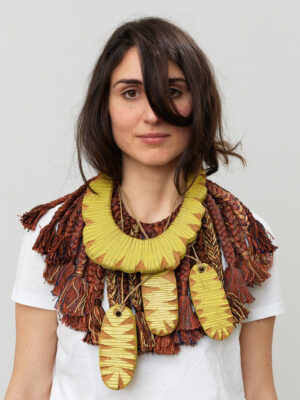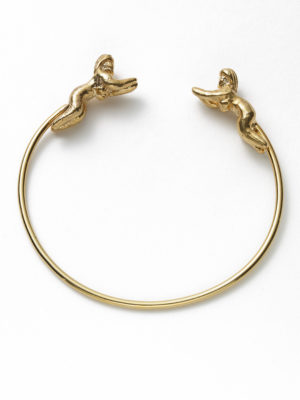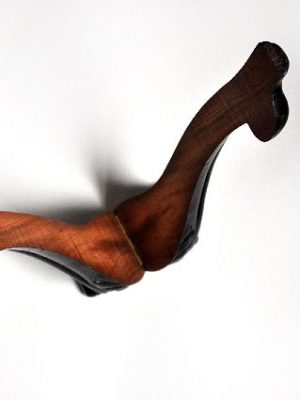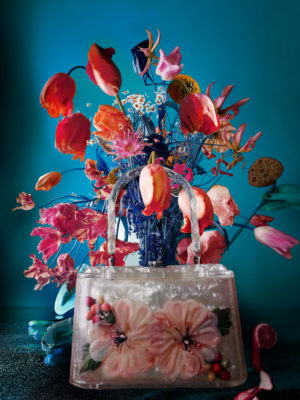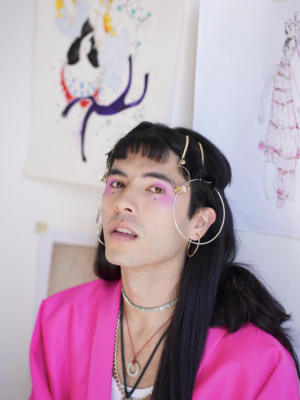Kellie Riggs: Silke, you describe your practice as an ‘adventurous path’ away from traditional goldsmithing. Can you describe what you mean by that?
Silke Spitzer: I think it was around 2009 or 2010 when I primarily started using materials like collected branches or abandoned slate tiles from my neighbour’s roof. The idea of creating from what was in reach, instead of reaching out far for material became something important. Values like the right shape or colour, tactility, weight, sound and such are now major components, and they express themselves in my jewellery or any art piece I make. The more object-based works have been hiding… or waiting to be born for quite some time. Painting and drawing have also always been my companion, I just didn’t have a big enough studio to create wilder scaled pieces for almost ten years, until now.
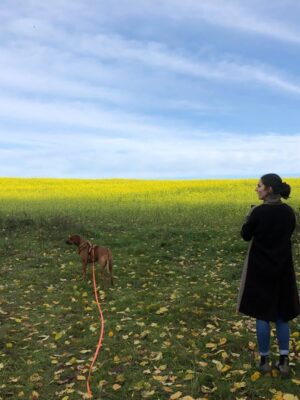
KR: Katherina, you are trained as a curator of modern and contemporary art. What brought you to jewellery, or how did you connect with Silke? ___STEADY_PAYWALL___
Katherina Perlongo: I had my first encounter with the world of contemporary jewellery about seven years ago. After my Bachelor’s degree in art history, I had returned to my hometown of Bolzano, Italy, working as an art educator at Museion, the Museum of Modern and Contemporary Art. At the time I felt an urgent need to do something with my hands and was very lucky to come across a goldsmith with whom I could study twice a week. She opened up the world of jewellery to me. When I moved to Berlin to continue my studies in art history, I also continued taking jewellery classes. I attended the annual Jewellery Week in Munich without knowing exactly what I was looking for. I followed my intuition, which led me to engage with this world and its actors.
I met Silke in Berlin, she was my jewellery teacher at the time actually. Very soon I realised that I was less interested in making jewellery myself, but that I was much more interested in understanding this world, putting it into context and linking my curatorial training to this field. I’m fascinated by the creative act, the inner necessity that a person feels to create something.
KR: What draws you to her work?
KP: In Silke’s case, this inner necessity can be felt very strongly. Her works are based on a primal need, the primordial creativity that has been inherent in people all over the world for generations. This is one of the reasons why her works have an archaic expression. What also fascinates me about her is that her artistic practice oscillates between disciplines. As a curator, I was used to separating the fine arts from the applied arts, but Silke keeps crossing borders between the two.
Her pieces are somewhere in between jewellery, wall objects and painting. For me, her approach and her creations are proof that the boundaries between fine and applied art make no sense, and that it is time after all to tear them down.
That is my approach as a curator. To liberate jewellery from ‘being craft only’ and bring it closer to the fine arts, to show that they are absolutely related to each other.
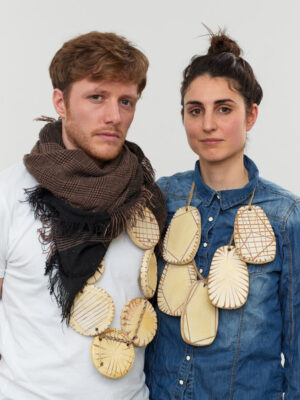
KR: Can you both speak to the project Talismania? How did it come about?
SS: Since quite some time, my neckpieces and amulets have been leaning towards a magical, or as I call it ‘talismanical’ direction. They come from my soul, expressed in materials from the world I live in. Any piece I make is an individual piece of art. As my neckpieces turn alive; I can’t help making them oversized. They grow into ritual objects, wall pieces or gowns rather than everyday neckpieces.
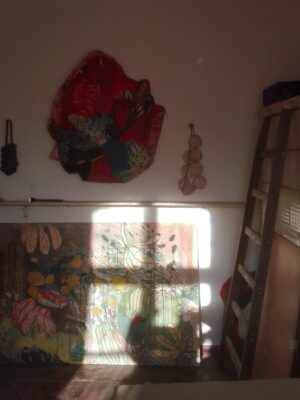
KP: In the last year I visited Silke’s studio pretty often. Fascinated by her approach and the pieces she was working on with extraordinary dedication, I began thinking of curating an exhibition. The eventual title, TALISMANIA, refers to Silke’s attraction to talismans — those objects and mementos to which a magical, auspicious effect is attributed. The exhibition showcases a collection of pieces she has created over the past three years.
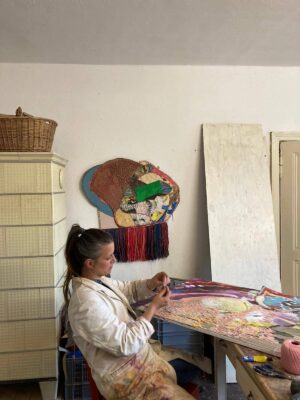
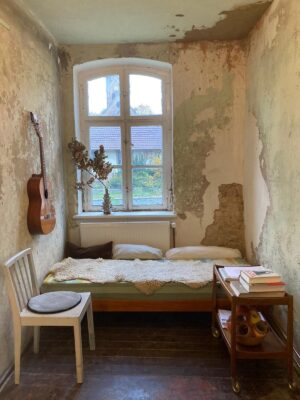
KR: Talismans and amulets are found in almost every culture and period in time across the globe, with a myriad of functions relative to each culture. Silke, in the creation of your own such objects, you’ve developed an interesting visual vocabulary. Where does it come from?
SS: My visual vocabulary is definitely mirroring the natural surrounding in which I live, combined with all the influences I see when I experience nearby Berlin. I used to commute to my studio everyday for the last 15 years; only since last August I’ve started to work at home and don’t go to the city as often.
I love contrast and strong expression, but also a soft breeze. The strongest contrast I can find, is being at home in nature in the morning, and then commute to Berlin later in the day. It feels like two worlds to me. In the subway, I am exposed to a multi-coloured, very diverse community.
I assume – besides my inspiration through nature, that I pick up colours, textures and rhythms from these commutes and weave it into my shapes.
Sometimes I even write my impressions down if I want to make sure to remember. This would be something like: ‘many shiny blue studs on a striped black and white dress, next to a matt brown paper bag’; or ‘two white braids with some yellowish strands in it, down to the chest on a 60- year-old women’. Maybe these notes will be seen in some interpretation later in a piece of art.
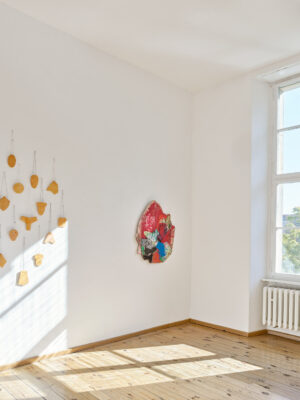
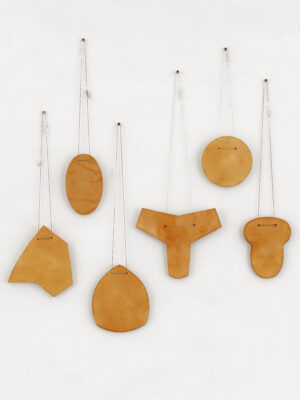
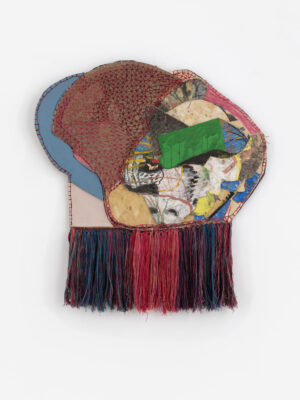
KK: Do you have any thoughts or concerns about cultural appropriation? Are there assumptions you or perhaps others might make of this work?
SS: Often people think my artwork is somehow related to Africa, or has some indigenous, tribal approach. It is not my intention, but of course I see the similarities. I am born and raised in Germany, the origins, traditions and memories I have are mainly German. But the origins I am looking for, with the search for truthfulness, are maybe the same as it has ever been in culture of the world. I think we all can find the same origins in ourselves. My expressions with simple materials and techniques aren’t unique; actually I aim to implement ‘global’ techniques. The braided necklaces I make are an example: braiding is a technique that has been used over centuries, and it is still being used. Mothers and fathers in any corner of the world are braiding their daughters’ hair, now, in the past, and also in the future. I think this fact is really beautiful. Somehow it gives me hope.
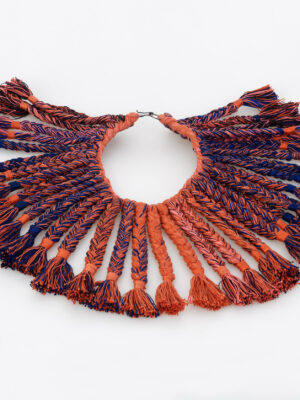
KW: What do your talismans aim to protect the wearer from?
SS: I think any kind of jewellery is very personal and always filled with a meaning that mainly the wearer / owner knows. I did the first amulet a few years ago for the mother of a new-born, a very close friend of mine. It was a small copper face on a string, to protect her and the baby from the evil eye. To me it is the idea that this amulet could be with her to give mental support in situations when no one else is around to lean on.
My neckpieces are meant to be worn in moments you might need some strength, maybe a moment like this one: A few weeks ago, me and my seven-year-old step son made a silver amulet with his name stamped on it to give him some courage going back to school after the long Corona break. He is a very small guy and he was afraid to be mobbed when he got back to school because he didn’t grow as much as the others. I told him to wear it a little bit in the morning before he leaves the house, just on his chest so it would feel like a hand on the chest to keep him calm, and to help him stand straight.
KR: That is a beautiful gesture. Can you tell us more about your philosophy of making with only things within reach?
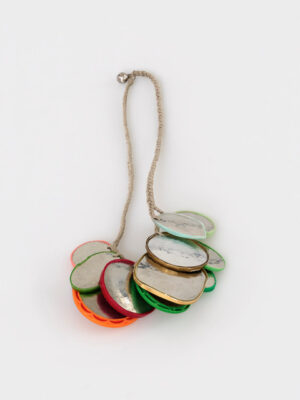
SS: I love the idea to use what I have / find on the street, to create something new. It’s like cooking, by only using what’s already in the fridge: often the best creations happen from that!
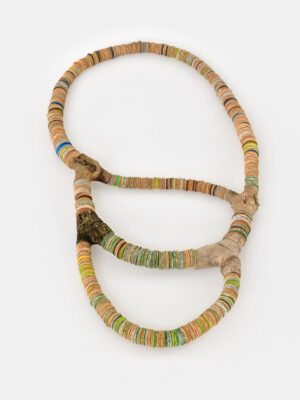
I mainly use common, often every day, or found materials and very simple techniques, like drilling holes in seeds from the cherry tree in the garden, braiding yarn, cutting or carving pieces of wood or paper. These methods have been used for centuries in any corner of the world. As I’m trying to find simple solutions, using common techniques is quite challenging in order to express my artistic approach. As a side effect though, working this way narrows down options, which I find very helpful in this overloaded world. In general, I often realize that if a problem is really complicated and hard to solve, the solution I aim for might not be the right solution yet.
As often in life, my working process also consists of the most simple solutions, the one right in front of me. Sometimes it just needs a little longer to be seen. Over all, my secret goal is to create a piece that I would pick up and take home when I find it on the street.
The artwork that comes from my hands mirrors the world I live in. Shapes, colours, and tactility are mainly inspired by my life in the countryside, half an hour commute from the eastern borders of Berlin. I live in a barn shaped building with lots of trees and greenery. In the morning, as I take the dog for a 40 minutes walk around the lake, I am planning my day. As I turn back home to have my first coffee with my boyfriend, I am fetching the chicken eggs. At this point in my life, work, home, family, animals…it’s all in one place and I can connect anything with everything. I am feeling very blessed to live the life I dreamed of and I am grateful for it every day.
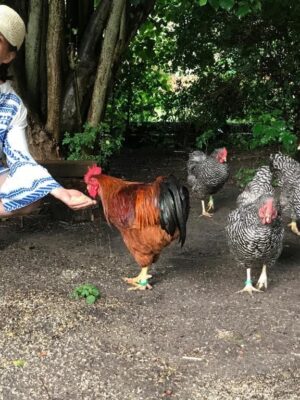
As you might understand now, my shapes are nature related, imitating leafs or other organic shapes: I mainly translate these shapes in natural or common material I happen to find in my daily life. Also the origin of the material is very important to me. I want it to be from me. From here. From my everyday life.
Many people think, for example, that the little wood pieces I use often are bamboo, but no! They are cut from dry branches of elder trees that are very common in the area. They are hollow on the inside and me and my friends used to make flutes out of it when we were children. Using materials that carry my own origin help to create my beloved feeling of having two feet on the ground.
This article is a part of the series commissioned by Current Obsession especially for Social Club Members, in relation to Munich Jewellery Week 2021.
